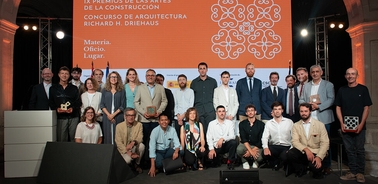IE University hosts the 2025 Building Arts Awards and Richard H. Driehaus Architecture Competition

The event included the opening of "Materia.Oficio.Lugar " (Matter. Know-How. Place.), an exhibition at the IE Creativity Center in Segovia.
This week, the Segovia campus of IE University hosted the awards ceremony for the 2025 Building Arts Awards and Richard H. Driehaus Architecture Competition. These prizes recognize the leading experts in traditional construction crafts in Spain and the architectural teams respectively for their proposals for each of three cities.
Both initiatives are promoted by the Traditional Building Cultures Foundation, under the auspices of Spain’s Ministry of Culture, in collaboration with INTBAU Spain and the Spanish Council of Architects’ Associations (CSCAE). The event was organized in collaboration with IE School of Architecture and Design, hosted by its Dean, David Goodman.
The ceremony was presided over by Susana Alcalde Amieva, Deputy Director General of Spain’s Institute of Cultural Heritage, alongside representatives of the organizing institutions: Miguel Larrañaga Zulueta, Vice-Rector for Students at IE University; David Goodman, Dean of IE School of Architecture and Design; José Franqueira Baganha, Vice President of the Traditional Building Cultures Foundation; Susana Moreno Falero, Dean of COACYLE, representing CSCAE; and Alejandro García Hermida, Executive Director of the Foundation and Chair of the juries for both initiatives.
This week also saw the opening of Matter. Know-How. Place., which runs until October 11 at the IE Creativity Center, located in Segovia’s historic La Casa de la Moneda (former Royal Mint). The exhibition explores the active role and potential of traditional building crafts in both architectural education and contemporary practice.
2025 Building Arts Awards: Celebrating the most outstanding master artisans
These annual awards recognize the work of Spain’s leading experts in traditional building crafts. The 2025 awardees are:
· Feliu Martín Farré, master stonemason from La Floresta (Lleida), for his outstanding work on major monuments including the Sagrada Familia in Barcelona.
· Miguel Ángel Tapia, master carpenter, woodcarver, and sculptor from Valladolid, honored for both his long-standing career and his efforts in training young carpenters.
· Manuel Monteserín, master thatcher from El Bierzo (León), for preserving the ancient technique of rye straw roofing used in traditional pallozas and hórreos of the northwest of Spain.
· Juan José Gómez Delgado, master blacksmith from Lebrija (Seville), for his excellence in iron forging and dedication to teaching and preserving the craft through his Forja Lebrija center.
To support the continuity of their work, Miguel Ángel Tapia and Manuel Monteserín will also receive funding to train an apprentice over a six-month period, with the apprentice receiving financial support during their training.
2025 Richard H. Driehaus Architecture Competition: Fostering more beautiful, rooted, sustainable, and inclusive architecture
The Richard H. Driehaus Architecture Competition is an international call to promote architectural and urban planning practices that preserve and revitalize the unique forms, materials, and character of local contexts. The aim is to create urban environments that are more beautiful, coherent, sustainable, and socially inclusive.
For this edition, the locations were: Baltanás (Palencia), Irurita (Baztán Valley, Navarra), and La Fresneda (Teruel). Architects from various countries submitted design and planning proposals for each location.
· Baltanás: The first prize was awarded to Identidad Estereotómica by Carlos Vallecillos Moya, Javier Navarro Mateos, and Guillermo Soria Alonso. Honorable mentions went to: Al Cotarro by Ramón Andrada González-Parrado and Alfonso Zavala Cendra; Los Corros del Cerrato by the Franco-Spanish studio Patio b (Blanca Aguilar and Benoît Souli). The mayor of Baltanás, María José de la Fuente Fombellida, offered words of thanks during the ceremony.
· Irurita: The first prize went to Ni Arrai!, designed by Javier Manén, Enric Mas, and Tomás Masó. Honorable mentions were awarded to: ¿Preparado para jugar? by Ramón Preciado Jiménez and Miriam Larumbe Vinuesa; Ventana abierta by Luis Felipe Pérez Villanueva, María del Carmen Crespo Pérez, and Laura de la Mata Morales. Fernando Anbustegi Goñi, Mayor of Baztán, highlighted the value of the proposals for the town’s Plaza de Rebote.
· La Fresneda: First prize was awarded to La Fresneda: Restoration of the Hillside by Polish architects Oskar Alaburda, Oskar Pawłowski, and collaborator Mateusz Chołuj. Honorable mentions went to: Fraxinus Excelsior by Víctor Guimerá Millán and María del Pilar Rama Lara; The Town on the Hill by Nefeli Eforakopoulou and Michael Cradock. The town’s mayor, José Ramón Gimeno Aguilar, praised the initiative and its outcomes.
Opening of Matter. Know-How. Place.
Coinciding with the award ceremonies, Matter. Know-How. Place. has opened at the IE Creativity Center (former Royal Mint of Segovia) and runs until October 11. The exhibition highlights the central role of traditional crafts in architectural education and contemporary design.
It features the work of the 2025 Building Arts Award recipients; the awarded proposals from the sixth edition of the Richard H. Driehaus Architecture Competition, and selected projects by master-apprentice pairs supported through the latest Donald Gray Grants for the Building Arts.
Also featured are the works of the 2024 awardees: Julio Barbero, expert in lime coatings and sgraffito (a hallmark of Segovian façades); Friedrich Bramsteidl, who has revived hydraulic hammer forging in Spain from Mazonovo, Asturias; Sebastián Pérez, master mason and brick sculptor from Fuentes de Andalucía (Seville); Max Rutgers, master carpenter based in Alt Empordà, Girona. The training work by Sebastián Pérez and Max Rutgers with apprentices José González Pérez and Paul Schickhofer is also showcased.
A special section is dedicated to the educational work of Wesam Al Asali, professor at IE School of Architecture and Design and coordinator of the collaboration with the Traditional Building Cultures Foundation. Al Asali integrates traditional craft knowledge into design education through workshops with local artisans and technologies such as augmented reality to explore new learning and creative methods.
Presented through drawings and references to specific works, the exhibition is an educational resource, inspiring new ways of teaching architecture where building and material experience take center stage in the learning process.

